It's not *just* the Roman Empire.
I am large. I contain multitudes. And I'm thinking about all of them right now.
“When was the last time you thought about the Roman Empire?”, my wife says, looking up from her phone.
I’d been anticipating the question.
I was already well aware of the social media trend going around, wherein women ask the men and/or boys in their lives when they last thought about the Roman Empire—a question that’s invariably met with a very-recent answer. I set down my own phone—putting aside the article I’d been reading about how to ferment my own Roman garum—and addressed the issue.
“I think about the Roman Empire a perfectly normal amount,” I said, a bit defensively and quite purposefully not specifying what I think is normal. “But I think about a lot of other things, too, you know.”
The root of this whole trend is, in my mind, an unspoken question: why are you thinking about that? It’s important to remember history, of course, but for the vast majority of people, the Roman Empire isn’t something they need to think about on any sort of regular basis. It’s not relevant to our daily lives, not when we could be thinking about current events, politics, the weather or our jobs instead.
Of course, those things are all boring, so I totally get it.
To be perfectly honest, though… the Roman Empire isn’t high on the list of irrelevant things I personally spend too much time thinking about. Sure, it’s in there—but there’s a lot of topics I think about even more often.
In fact, I made a chart.
Or, rather—to borrow from another recent social media trend—it’s a mood board.
It’s a matrix of the things I’m thinking about plotted on two axes, one from “is this important or trivial?” and one from “is this silly or kind of tragic?”.
Let’s review.
The Origins and Causes of World War I
At a certain point in any Dad’s life, they must choose a war to become obsessed with. For me, that’s the First World War, because it’s just so complex. The alliances! The motivations! The clueless leaders and feckless royals!
I thoroughly enjoyed—inasmuch as one enjoys this sort of thing—Christopher Clark’s The Sleepwalkers: How Europe Went to War in 1914.
The Troubles
In the last couple years, I have devoured two books on The Troubles—Patrick Radden Keefe’s Say Nothing, and Rory Carroll’s There Will Be Fire. It is fascinating to me how close all of this was historically—many of the main figures are still alive!—and how far away it feels now.
The Johnstown Flood
Some rich guys formed a hunting club, and it led to an entire town being swept away by a wall of water. David McCullough’s The Johnstown Flood is 55 years old and hasn’t aged a day. Did I drive out of my way to see the former site of the South Fork Hunting and Fishing Club on a recent trip through Pennsylvania? You already know that I did.
The Yukon Gold Rush
It sounds horrible. Lots of people froze to death and almost no one made money except for grifters and thieves. I love it. Brian Castner’s Stampede is good.
The Great Molasses Flood
I absolutely cannot picture how big this tank of molasses was or how it was able to kill dozens of people, and I cannot stop thinking about it.
The Death of Garry Hoy
I cite this Wikipedia article far too frequently in normal conversations.
Garry Hoy (January 28, 1954 – July 9, 1993) was a Canadian lawyer who died when he fell from the 24th floor of his office building at the Toronto-Dominion Centre in Toronto, Ontario. In an attempt to prove to a group of prospective articling students that the building's glass windows were unbreakable, he threw himself against the glass. The glass did not break when he hit it, but the window frame gave way and Hoy fell to his death.
Why. Why was he doing that.
The Yellowstone Supervolcano
I’m keeping my eye on it.
Notable Air Disasters
Some nights you need to get a good night’s sleep, and some nights you need to stay up until 2am reading about the Tenerife disaster.
The Assassination of President James A. Garfield
“Assassination” feels unfair, because—well, yes, President Garfield was shot by delusional office-seeker Charles Guiteau, but… he was killed by his doctors spending the next several months poking his wound without washing their hands.
I find that whole period of American history super interesting and Candice Millard’s Destiny of the Republic convinced me Garfield would’ve been a pretty good president if his doctors knew about bacteria.
The Murder of Stanford White
I mean, I’m an architect, so there’s that. But I also love turn-of-the-century New York stories, and “celebrity architect shot dead at a party and everyone thought it was an elaborate party trick at first because that was the style at the time” is a hell of a story.
Also, I went as Dead Stanford White for Halloween in 2014.
The Roanoke Colony
Where’d they go?
The Centralia, Pennsylvania mine fire
Someone accidentally lit a coal mine on fire in 1962 and it’s still burning, and may continue to do so for hundred of years! What’s not to love?
The Panama Canal
If someone ever gets a boat stuck there it will be the greatest week of my life.
The Great Lakes
I was born in Cleveland and quietly but firmly harbor a belief that the Great Lakes region is the greatest place in the world, but I’m also preoccupied with their delicate ecology. Dan Egan’s Death and Life of the Great Lakes is way more interesting than you’d think a book that spends a lot of time talking about carp should be.
The 1893 World’s Columbian Exposition
There’s a lot to be said about the White City and everything around it, but I still think about my architecture school director’s strongly-held belief that John Wellborn Root dying (of pneumonia, because he insisted on seeing dinner party guests out in the cold without a coat) in 1891 and leaving the fair’s planning in the hands of his less-talented partner Daniel Burnham set back American architecture by decades.
[J. Walter Weatherman voice] and that’s why you always wear a coat!
Citicorp Center Engineering Crisis
In 1978, two architecture students—Diane Hartley and Lee DeCarolis—separately raised questions about the wind loads on this recently-completed Manhattan skyscraper, prompting lead structural engineer William LeMessurier to re-check his work and realize that an unusually-strong windstorm could topple the building.
Repairs were completed in secret and the public was not made aware until 1995.
The Emu War
In 1932, Australia waged war on emus with machine guns, and they lost the war.
Woodstock ‘99
Yes, it was a disaster—and a corporatized perversion of the ideals of the original festival. But it happened when I was 17 and I loved all of the acts involved. I watched the entire thing on Pay-Per-View and many of those sets are available in full on YouTube now. Like Korn!
[guttural] arrrrrrre yooooouuuu reaaaadyyy
The New Madrid Earthquake of 1811
One of these days it’s gonna do it again.
Robert Moses
He amassed power that couldn’t be challenged by mayors or governors, shaped modern New York City in ways more profound than possibly any other person, and he also had some really terrible ideas that he didn’t get to do.
Also, The Power Broker is one of the greatest works of biography ever written.
Unfinished Construction Projects
I love them all, but especially the Ryugyong Hotel in Pyongyang, or The Harmon in Las Vegas.
Bicycles
I just think they’re neat.
The Fenn Treasure
In 2010, wealthy art dealer Forrest Fenn buried a treasure chest full of gold and jewels somewhere in the Rocky Mountains, then published a cryptic poem suggesting its whereabouts. Thousands of people searched for a decade, and a handful even died looking for it. It was found in 2020, though there’s still conspiracy theories about it.
This was a large part of the inspiration for Where in the #@&% is Glen From Cincinnati, my restaurant-finding game that wraps up this week.
For further reading, Daniel Barbarisi’s Chasing the Thrill is a good account of it all.
BALLOONFEST ‘86
In 1986, the city of Cleveland released 1.5 million balloons into the air, an event that looked very cool and also may have led indirectly to the deaths of two fishermen.
You should watch this six-minute short film. It’s amazing, and prominently features Cleveland icons Big Chuck & Little John.
I grew up in Cleveland, and my parents took my brother and I (ages 7 and 4) to see Balloonfest. We missed the (early) launch because one of us needed to use the bathroom in my dad’s office.
I don’t know which one of us it was, so I’ll blame my brother.
Proposed US states that never became states
The people pushing for “Greater Idaho” right now are all kooks and cranks, but they’re also keeping up a longstanding American tradition.
(Of being kooks and cranks.)
The 1995 Cleveland batting order
In 1995, Cleveland had three eventual members of Major League Baseball’s 500-home-run club batting 5-6-7 (Eddie Murray, Jim Thome, Manny Ramirez), and none of them were the team’s best hitter (Albert Belle).
I think about this at least twice a week.
There’s an abandoned subway in Cincinnati!
The train, not the sandwich shop. Although there’s probably a few of those, too.
Rube Waddell
I mean, I have a fascination with old-timey baseball in general, but let this excerpt from Wikipedia explain why I love this turn-of-the-century ballplayer’s story:
He was notably unpredictable; early in his career, he once left in the middle of a game to go fishing. He also had a longstanding fascination with fire trucks and ran off the field to chase after them during games on multiple occasions. He would disappear for months at a time during the offseason, and it was not known where he went until it was discovered that he was wrestling alligators in a circus. He was easily distracted by opposing fans who held up puppies, which caused him to run over to play with them, and shiny objects, which seemed to put him in a trance.
He was Andy Dwyer from Parks and Recreation, but with a devastating curveball.
The Principality of Sealand
“Since 1987, when the United Kingdom extended its territorial waters to 12 nautical miles, the platform has been in British territory.” (Wikipedia)
Okay but the British have lost plenty of territorial claims before. Don’t give up now.
Lawnchair Larry
On July 2, 1982, Larry Walters (April 19, 1949 – October 6, 1993) made a 45-minute flight in a homemade aerostat made of an ordinary patio chair and 45 helium-filled weather balloons. The aircraft rose to an altitude of about 16,000 feet.
Between this and BALLOONFEST ‘86, the 1980s were a tremendous time for combining helium and bad ideas.
The Russian domesticated silver fox experiment
In the 1950s, Russian researchers selectively bred foxes for their tameness and agreeability toward humans, and in basically four generations they turned them into dogs.
Old baseball parks
YOU: builds a time machine to get rich and/or prevent historical tragedy
ME: builds a time machine to go to Tiger Stadium
Recursive Island and Lakes
Because it’s just good to know that, somewhere in Canada, there is an island in a lake on an island in a lake on an island in a lake.
The Phantom Time Conspiracy
I don’t like the direction society has gone with conspiracy theories lately. There’s way too many of them out there, and way too many of them are racist/dangerous/insane.
I like a good, low-stakes conspiracy theory, like this one, that posits that Holy Roman Emperor Otto III had calendars skip ahead 297 years—fabricating the entire Carolingian Period—in order to make the year 1000 AD fall during his reign.
It’s great because it’s: a) totally bonkers b) sounds like it could be true and c) absolutely is not true and has been easily disproven by reliable sources.
Defunct Restaurant Chains
I bought a jar of Chi-Chi’s brand salsa at the store the other day, and it just made me wistful for what we’ve lost. No jar of salsa can bring back the fried ice cream.*
*I don’t know if I ever actually had it but the idea is compelling
Old College Mascots
They’re uniformly terrifying and I love them all.
This isn’t just about me, though, and I don’t think it’s gender-specific, either. What are your Roman Empires?
What are you thinking about all the time? Let’s hear it.
—Scott Hines (@actioncookbook)

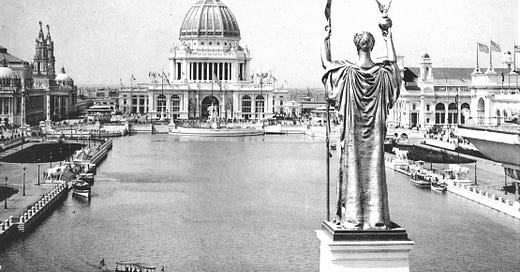

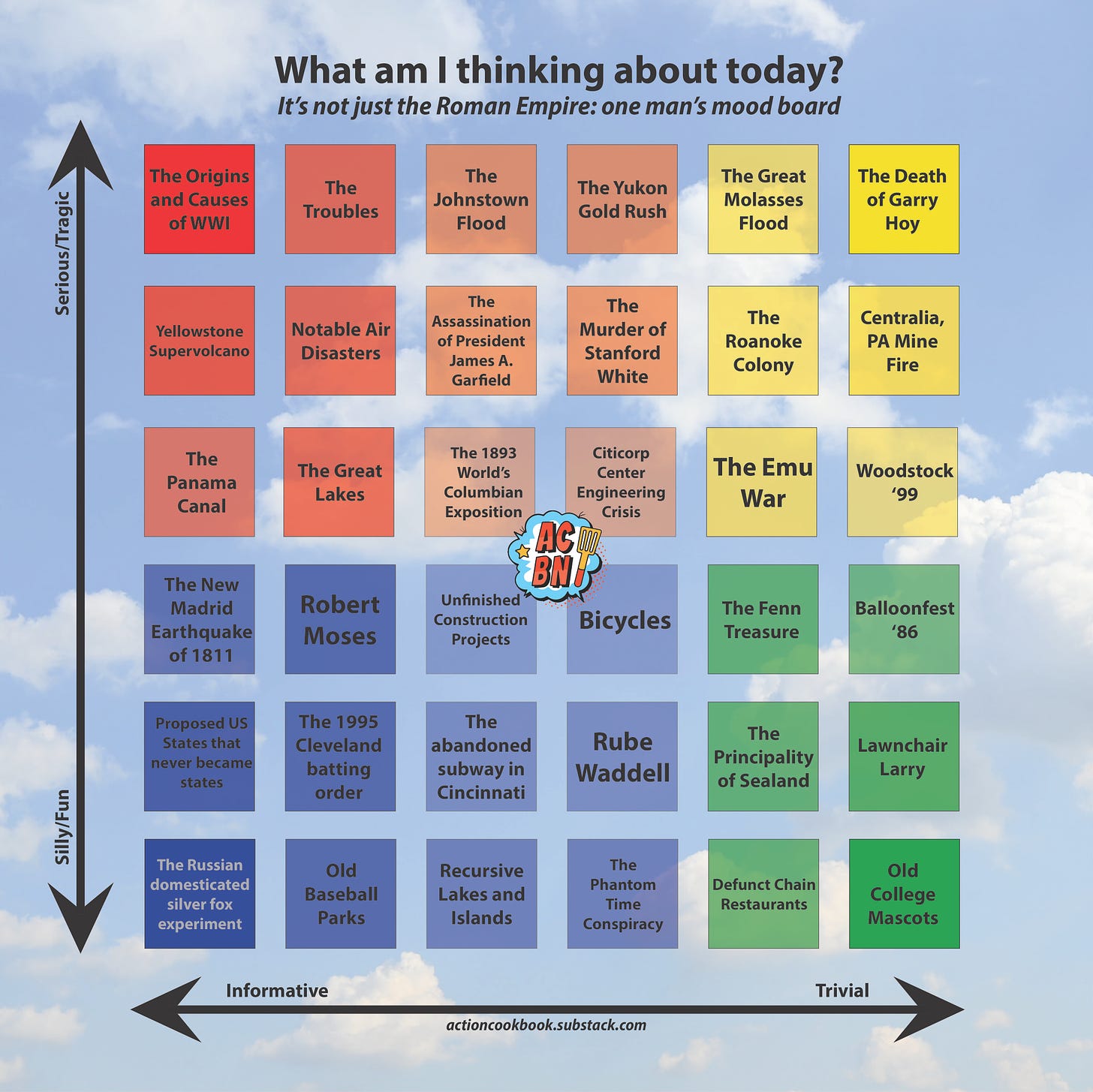
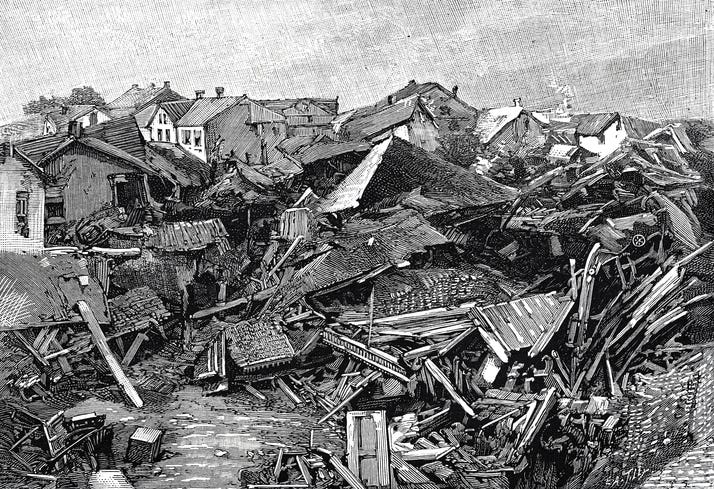
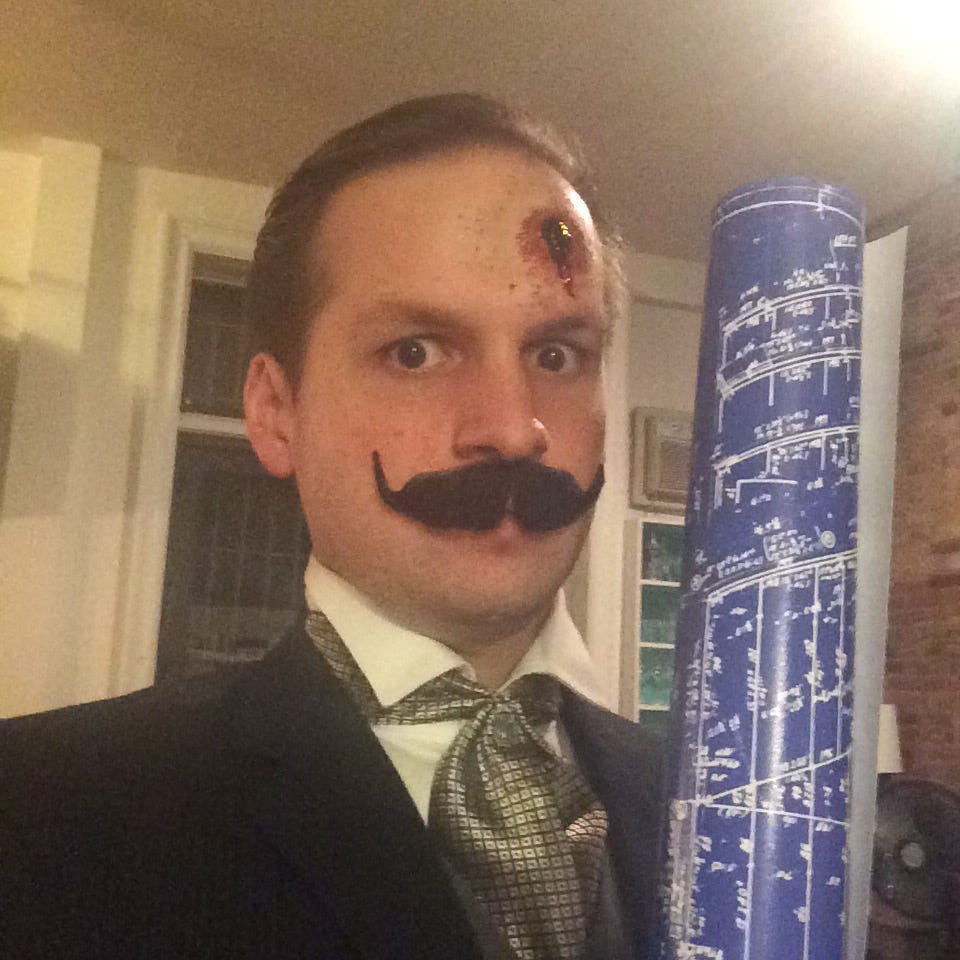



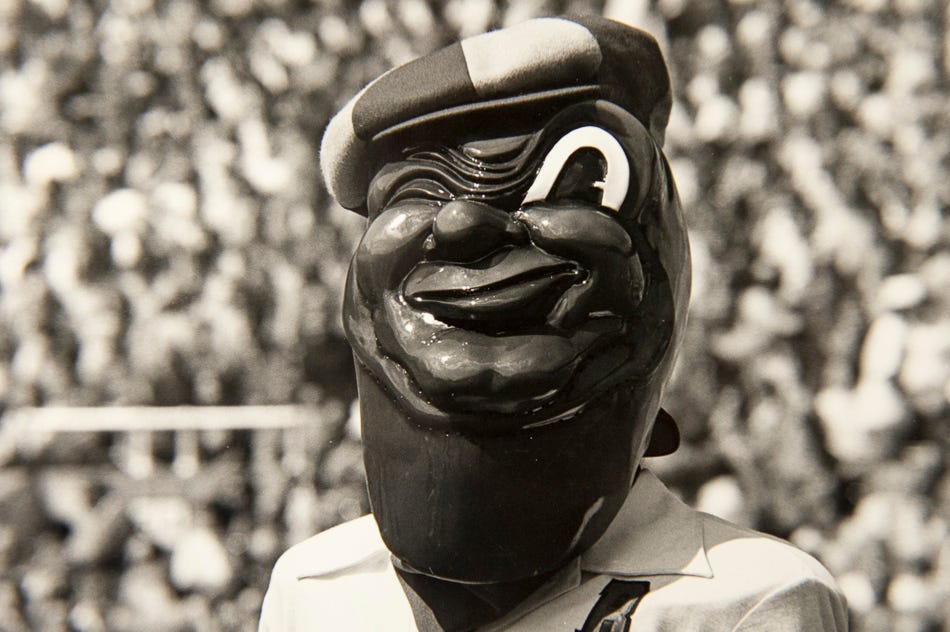
I think way too much about how the hell we figured out what was edible and how to make certain things that we take for granted now. For instance, cheese requires a very specific enzyme from a stomach of ruminant animals -- what the hell was going on to make that happen? Who was running around sampling mushrooms and berries and figuring out the good ones and how many people died? Who found a long-forgotten flour and water mixture and decided to bake something with it and call it 'sourdough'?
Anyway, now I'm just curious about Daniel Burnham sins against American architecture.
I used to work landscaping at Lakeview cemetery, and I "got" to sweep/mop around the caskets in Garfield's tomb.
Relatedly, if you ever find yourself with a couple hours to kill in Cleveland, Garfield's tomb has great views of the lake and the skyline from the observation deck, and there's a gorgeous chapel that's all Tiffany glass. Easily a top three cemetery tourist attraction in the US. (Although now that I think about it, DC, New Orleans, and maybe a few other places might have it beat)